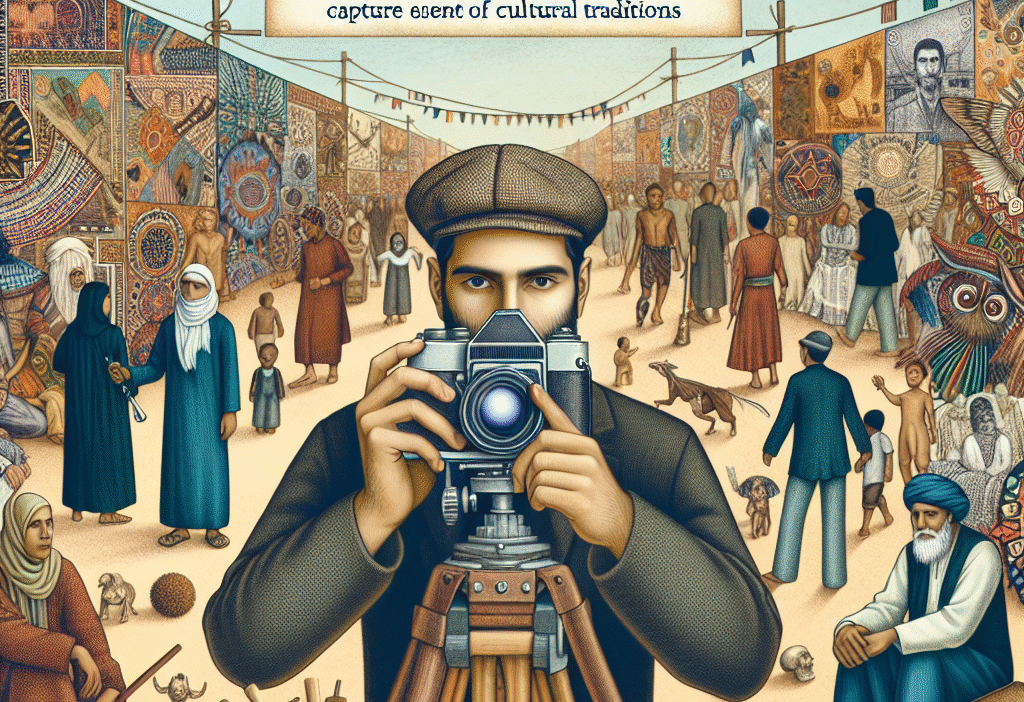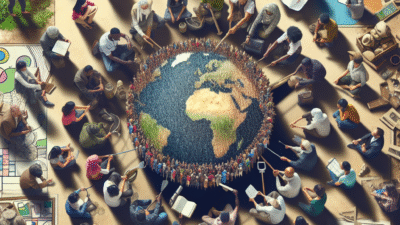Through the Lens: How Visual Anthropology Captures the Essence of Cultural Traditions
Introduction
In a world brimming with varied cultural tapestries, understanding the intricate threads that weave them together has never been more crucial. Visual anthropology, a field that fuses sociology, anthropology, and visual arts, does just that—capturing the essence of cultural traditions through the lens of the camera and film. This article delves into how visual anthropology serves as a powerful tool in documenting, preserving, and celebrating cultural identities, traditions, and rituals.
Imagine standing amidst a vibrant festival, feeling the energy of drums pounding in your chest as colorful dancers twirl in intricate attire. It’s not just what you see; it’s the story behind those movements, the significance of the garments, and the community’s shared history that matters. Through visual anthropology, these stories are articulated, recorded, and immortalized.
In this comprehensive exploration, we will cover the methodology, prominent themes, impactful case studies, and the significance of visual anthropology in modern society. You’ll come away with a nuanced understanding of how this discipline captures cultural traditions and why it is essential for preserving our global heritage.
The Foundations of Visual Anthropology
Origins and Evolution
Visual anthropology has its roots in ethnography, the systematic study of people and cultures. The field gained momentum in the mid-20th century as researchers realized the potential of film and photography as a means of storytelling. Early pioneers like Margaret Mead utilized visual methods to enhance their ethnographic work, showcasing the importance of visuals in understanding cultural contexts.
Methodologies in Visual Anthropology
Participant Observation: Engaging with the community on a personal level allows anthropologists to capture lived experiences authentically. This method supports a deeper understanding of cultural traditions beyond surface-level observation.
Documentary Filmmaking: Filmmakers create narratives that delve into specific cultural practices, providing an engaging platform for broader audiences. Documentaries often combine interviews, narrative storytelling, and ethnographic insights.
Photography: Static images can convey complex stories and emotions. Photographs serve as a visual representation of daily life, rituals, and important cultural moments.
- Digital Media: The rise of technology has allowed for innovative approaches in visual anthropology. Utilizing social media platforms to disseminate visual narratives creates dynamic interactions with global audiences.
(Insert Table 1: Overview of Methodologies in Visual Anthropology)
| Methodology | Description | Key Benefits |
|---|---|---|
| Participant Observation | Immersive engagement with subjects | Authentic insights |
| Documentary Filmmaking | Narrative storytelling through visual media | Wider audience reach |
| Photography | Capturing still images of cultural moments | Emotional resonance |
| Digital Media | Use of technology and social platforms | Expanding accessibility |
The Power of Visual Storytelling
Engaging Audiences
Visual anthropology captures attention in ways that textual descriptions may not. By engaging viewers visually, anthropologists can evoke emotions and provoke thoughts that disrupt preconceived notions about cultures.
Visual Symbols: Colors, patterns, and symbols tell tales of cultural identity. For example, the red in a traditional Chinese wedding dress symbolizes luck and prosperity, a story that can be conveyed through a single image.
- Cinematic Techniques: Techniques such as slow-motion, close-ups, and background scores in documentaries can encapsulate the mood of cultural practices, enhancing viewer engagement.
(Insert Chart 1: The Impact of Visual Techniques on Audience Engagement)
| Technique | Emotional Impact | Example |
|---|---|---|
| Close-ups | Builds intimacy | Emotional faces during rituals |
| Slow-motion | Highlights significance | Dancing movements in festivals |
| Background Scores | Sets the tone | Music during traditional events |
Case Studies in Visual Anthropology
Celebrating Cultural Festivals
Take the example of the Diwali festival in India. Through the lens, anthropologists have captured the vibrancy and communal spirit of this festival.
- Cultural Narratives: Visual media portrays the underlying narratives of Diwali, such as the triumph of light over darkness.
- Emotional Connection: Footage from families participating in rituals forms a deeper emotional connection for viewers, highlighting the communal aspect of the celebration.
Documenting Habitat and Lifestyle Changes
Visual anthropology is crucial when examining how modernization impacts indigenous cultures. For instance, consider the Inuit communities of the Arctic.
- Vanishing Traditions: Through visual storytelling, anthropologists depict traditional hunting methods juxtaposed against the challenges posed by climate change and globalization.
- Reclaiming Narratives: By allowing indigenous voices to articulate their experiences, visual media can reclaim narratives that have been historically marginalized.
Bridging Cultural Divides
Visual anthropology also works as a bridge between cultures. By showcasing the richness of one culture to another, it fosters understanding and appreciation.
- Cultural Exchanges: Film festivals dedicated to visual anthropology allow for exchanges where cultures can be celebrated and misinterpretations addressed.
(Insert Table 2: Examples of Effective Case Studies in Visual Anthropology)
| Case Study | Key Themes | Insights Gained |
|---|---|---|
| Diwali Festival | Community spirit, tradition | Emotional connection to rituals |
| Inuit Communities | Impact of globalization, climate change | Reclaimed narratives |
| Cultural Exchanges | Mutual understanding | Fostering cultural appreciation |
Visual Anthropology in the Modern Age
The Role of Technology
In the era of smartphones and instant sharing, visual anthropology has transformed. Anthropologists now use platforms like Instagram, Snapchat, and YouTube to reach broader audiences.
- Micro-Stories: Short videos and photos can share micro-narratives that speak volumes about cultural practices.
- Interactive Engagement: Engaging audiences in real-time interaction through live streams fosters a sense of participation.
Challenges in the Digital Era
However, with this technological advancement come challenges. The commodification of cultures—where their rich meanings can be diluted for commercial gain—risks the very essence that visual anthropology captures.
- Ethics of Representation: Anthropologists must navigate issues of consent, representation, and ownership of cultural narratives.
Conclusion
Through the lens, visual anthropology beautifully captures the essence of cultural traditions, weaving stories that resonate across boundaries. By employing various methodologies and engaging audiences, it fosters mutual understanding and appreciation of diverse cultures.
This discipline not only preserves cultural identities but also acts as a vehicle for social change, allowing marginalized voices to emerge and share their narratives. As we confront the challenges of globalization and modernization, understanding the role of visual anthropology becomes indispensable.
Visual storytelling invites you to become a participant in this evolving narrative. Embrace it and explore how you can engage with visual traditions, whether by sharing your culture or learning from others.
FAQs
1. What is visual anthropology?
Visual anthropology is a subfield of anthropology that uses visual media, such as photography and film, to study and represent cultural practices and social phenomena.
2. How does visual anthropology differ from traditional anthropology?
While traditional anthropology relies heavily on textual descriptions and ethnography, visual anthropology focuses on visual representations, enhancing cultural narratives through images and film.
3. What ethical considerations should visual anthropologists be aware of?
Visual anthropologists must consider issues related to consent, representation, and cultural sensitivity, ensuring they portray subjects authentically and respectfully.
4. How can visual anthropology promote cultural understanding?
By showcasing diverse cultural practices through engaging visual narratives, visual anthropology bridges cultural divides and fosters appreciation and respect among different communities.
5. Can anyone practice visual anthropology?
While formal training in anthropology is beneficial, anyone passionate about culture and storytelling can engage in visual anthropology. Using digital media tools allows individuals to share cultural narratives innovatively.
By demystifying cultural traditions through compelling visuals, visual anthropology offers a lens into the heart of diverse communities, enriching our understanding of human experiences across the globe. ✨
(Insert additional high-quality image relevant to visual anthropology)
For more on how visual anthropology intertwines with diverse cultures, visit myjrf.com for insightful resources and stories.





